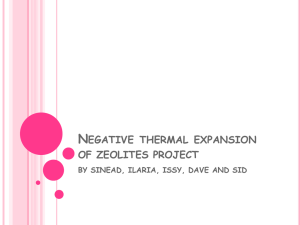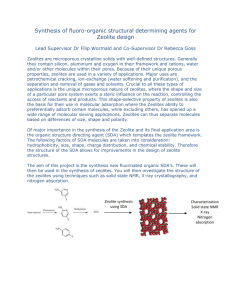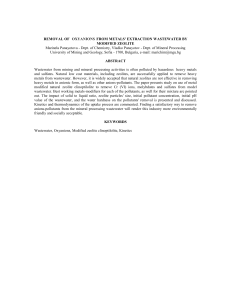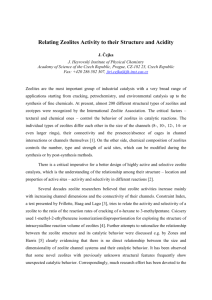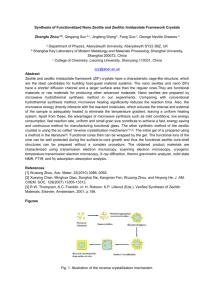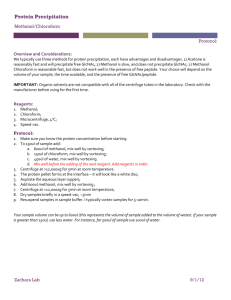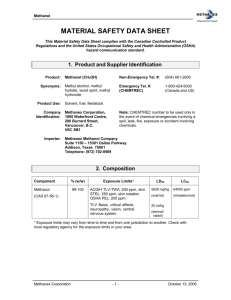Mass balance obtained - Springer Static Content Server
advertisement
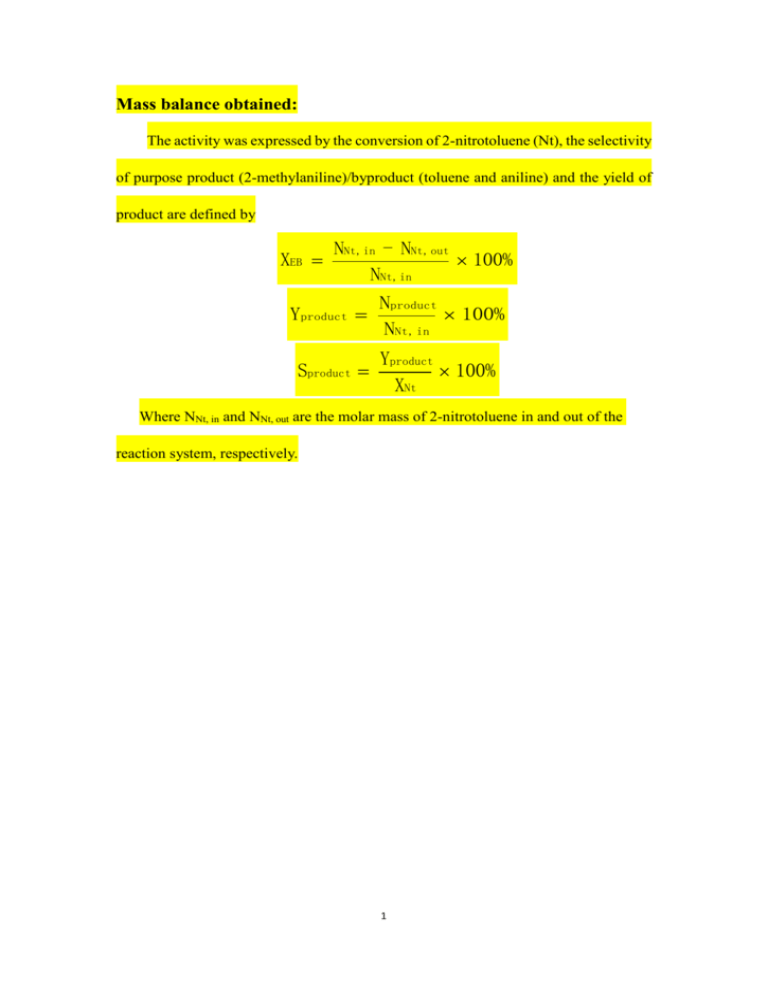
Mass balance obtained: The activity was expressed by the conversion of 2-nitrotoluene (Nt), the selectivity of purpose product (2-methylaniline)/byproduct (toluene and aniline) and the yield of product are defined by XEB NNt, in - NNt, out 100% NNt, in Yproduct Nproduct 100% NNt, in Sproduct Yproduct 100% XNt Where NNt, in and NNt, out are the molar mass of 2-nitrotoluene in and out of the reaction system, respectively. 1 Characterization 1. XRD Figure S1 XRD patterns of different ion-exchanged X zeolites As can be seen in Figure S1, all the samples exhibit sharp XRD peaks at 6.2, 10.1, 15.5, 23.4, 26.7 and 31.0°, which are the characteristic peaks of the faujasite structure. However, the strength of characteristic diffraction peaks slightly decreased, compared to NaX. This change may be attribute to the damage of the framework of zeolites in the process of ion exchange. Besides, CsX zeolite showed the different intensity distribution. The peak at 15.5° almost disappears, and the peaks at 25.43° and 29.20° significantly increase. It attributes to the incorporation of Cs cations, which have different scattering properties. In addition, neither obvious shift in the peak positions nor significant diffraction lines assigned to any new phase were observed in the XRD patterns of the modified samples. Above these facts indicate that the crystal structure of X zeolite is remained after ion exchange. 2 2. SEM Figure S2 SEM image of different ion-exchanged X zeolites (A) NaX; (B) HX; (C) KX; (D) CsX SEM images for modified X zeolites are shown in Figure S2. As can be seen, the crystal morphology of X zeolite catalysts experiences no significant change after modified by ion-exchange, indicating that X zeolite modified by ion-exchange do not cause damage to the crystal morphology. SEM images of NaX and CsX are similar to those of HX and KX, and both of them show cubic crystal particles with the approximate size of 2-4m. The SEM images of HX and KX show that the solid product had a slightly rough surface, compared to NaX, which suggested that the product contained a small amount of amorphous phase and with a little lower crystallinity. 3 Tables Table S1. The specific surface areas and volumes of the modified X zeolites Sample BET surface area (m2g-1) Micropore volume (cm3g-1) Mesopore volume (cm3g-1) KED (%) NaX HX KX CsX 486.7 391.5 442.1 387.3 0.22 0.13 0.15 0.14 0.15 0.17 0.14 0.12 -94.13 87.26 62.87 The KED was calculated according to the following formula: 𝐾𝐸𝐷 (%) = 𝑊𝑁𝑎,𝑖 − 𝑊𝑁𝑎,𝑡 × 100 𝑊𝑁𝑎,𝑖 Where WNa,i and WNa,t are the mass percentage of Na in the initial NaX and treated zeolite, respectively. Experimental 1. Acidity/alkalinity characterization of different modified X zeolites The characterization of surface properties of materials as acid catalysts or base catalysts is necessary for predicting the catalytic performance. For X zeolites, several methods were reported, such as indicator/titration methods, use of probe molecules, calorimetry and temperature programmed desorption, spectroscopy of adsorbed molecules, and test reactions, etc. Generally, the base catalysts lead to side-chain alkylation in aromatic alkylation, while the acid catalysts bring about ring alkylation. For example, the reaction of toluene with methanol over basic zeolites produces styrene and ethylbenzene, while xylenes 4 were formed over acid zeolites. Therefore, this catalytic reaction system could be used for identifying the surface acidity or basicity of the modified X zeolites in this work. The results are shown in Table S2. As listed in Table S2, different X-type zeolites exhibited different reactivity in the alkylation of toluene with methanol. KX and CsX presents 3.91% and 7.10% conversion of side-chain alkylation of toluene with methanol with producing only ethylbenzene and styrene. HX and HX-5%Cs2O zeolite catalysts led to aromatic-ring alkylation (9.25% and 3.91% conversion of toluene), with xylenes as the main product. NaX zeolite catalysed the side-chain alkylation and aromatic-ring alkylation simultaneously, with the reaction products of styrene (6.50%), ethylbenzene (13.52%), xylenes (55.83%) and other aromatics (24.15%). Above these facts imply that alkali cation-exchanged zeolites such as KX and CsX mainly possess base sites, and NaX zeolite possesses some weaker base sites and some acid sites. In contrast, there are mainly acid sites on HX and HX-5%Cs2O zeolites. Different types of alkali metal ion-exchanged X zeolites were applied to the side chain alkylation of toluene with methanol. It found that total basicity of molecular sieve was proportional to the catalytic activity of sidechain alkylation of toluene with methanol, the catalytic activity of CsX was higher than KX. Other methods through adjusting the acid-based property of X zeolite came to the same conclusion. From Table S2, X zeolites modified by K+, Cs+ showed higher catalytic activity for the side-chain alkylation, whereas HX zeolite showed higher catalytic activity for the aromatic-ring alkylation. This 5 phenomenon arises from the order of total alkalinity of X-type zeolites, ranking as HX < NaX < KX < CsX. Table S2. Different X-type zeolites for the alkylation of toluene with methanol Product selectivity (%) Toluene Catalyst conversion Other Styrene Ethylbenzene Xylene (%) aromatics NaX 1.21 6.50 13.52 55.83 24.15 HX 9.25 0 0.72 87.92 12.08 HX6.16 0 0 82.36 16.92 5%Cs2O KX 3.91 20.62 79.38 0 0 CsX 7.10 20.70 79.30 0 0 Reaction conditions: 703 K, Toluene/Methanol molar ratio of 5.0, WHSV of 1.0 h -1, atmosphere pressure (N 2), N2 flow rate of 30 ml/min. The amount of acid sites and basic sites of the modified X zeolites were also characterized by IR with pyridine adsorption and phenol adsorption, as shown in Table S3&Table S4, respectively. Obviously, the total acidity of X-type zeolites was in order of HX > HX-5%Cs2O > NaX > KX > CsX, whereas the total basicity behaved a completely opposite tendency. The loading of Cs2O or ion exchange with K+, Cs+ increased the total basicity of X zeolite, which significantly accompanied with the reduction of acidity. The characterization results are in accordance with results obtained from the reaction of the alkylation of toluene with methanol. 6 Table S3. Determination of the acidic sites of the modified X zeolites by IR with pyridine adsorption Zeolites HX HX-5%Cs2O NaX KX CsX Bronsted acid (mmol/g) 473 K 673 K 1.82 0.35 0.31 010 0.08 0.01 0.06 0.01 0.04 0.00 Lewis acid (mmol/g) 473 K 673 K 0.64 0.10 0.40 0.07 0.13 0.02 0.11 0.02 0.07 0.01 Table S4. Determination of the basic sites of the modified X zeolites by IR with phenol adsorption Basic sites /(mmol/g) Zeolites 473 K 673 K HX 0.06 0.03 HX-5%Cs2O 0.19 0.05 NaX 0.43 0.09 KX 0.76 0.24 CsX 1.12 0.33 2. The effect of temperature on transfer hydrogenation of 2-nitrotoluene with methanol Figure S3 The effect of temperature on the transfer hydrogenation of 2-nitrotoluene with methanol The transfer hydrogenation of 2-nitrotoluene with methanol operated in differential temperature, the reaction results are shown in Figure S3. The transfer hydrogenation only occurred upon 673K. With the increase of reaction temperature, the 7 conversion of 2-nitrotoluene increased gradually. The selectivity of 2-methylaniline increased before decreasing, 2-methylaniline reached the highest yield at 718K. Therefore, the proper reaction temperature for the transfer hydrogenation of 2nitrotoluene with methanol to 2-methylaniline was 718K. 3. The catalytic stability with time on stream As shown in Figure 1, the conversion of 2-nitrotoluene slighted decreased after 4h. The catalytic performance of KX decreased obviously after 8h, and the catalysts became deep black. Figure S4 TG of the used KX zeolite The TG curve of the used KX has two obvious weight loss peaks located at 348 ~ 793 K and 793 ~ 1155 K, respectively. The first weightlessness peak should be attributed to the peak of desorption of volatile organic compounds or decomposition components, the second weight loss peak is assigned to the decomposition of coke. After 8 h, the amount of coke over KX is 34.23%. The used zeolite was calcined at 973 K for 6 h in air atmosphere, then the catalyst activity and the selectivity of styrene could be almost recovered to the level of fresh catalyst, as shown in Table S5. Therefore, it can be confirmed that coke deposition on KX zeolite is the main reason for the catalyst deactivation in the transfer hydrogenation of 2-nitrotoluene with methanol. 8 Table S5. The transfer hydrogenation of 2-nitrotoluene with methanol over fresh KX catalyst and regenerated KX catalyst Conversion (%) Selectivity (%) Catalyst 2-Nitrotoluene Methanol Toluene Aniline 2-Methylaniline Fresh 73.09 49.71 5.79 36.02 58.19 Regenerated 66.97 60.45 6.96 42.17 50.87 Reaction conditions: 703 K, Toluene/Methanol molar ratio of 5.0, WHSV of 1.0 h-1, atmosphere pressure (N 2), N2 flow rate of 30 ml/min. 9
